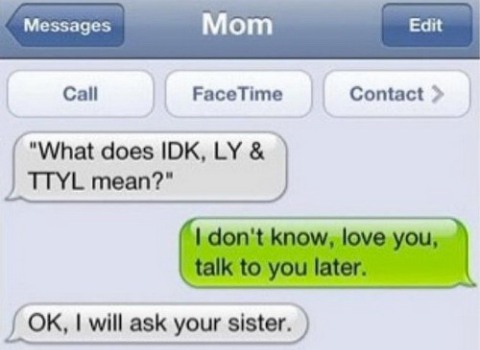We live in an age where the internet has become such an integral part of our lives that it has given rise to a new culture – the internet culture. Teens take the lead in embracing the new internet culture. Their generation straddles the century change, hence they are often called the Millennial Kids. They are bombarded by stimuli such as video games, smart phones, iPads, social medias such as Facebook, emails, text messaging, Skype, Viber and online chatting.
With the meteoric rise of web-based technologies, social media platforms, online chatting, email and instant messaging, the way we communicate has evolved and given rise to a unique internet language sometimes known as millennial jargon.
Hundreds of bizarre expressions have spawned as a result. English teachers cringe at this new lingo where grammars, capitalization and punctuation are optional. In text messaging, lowercase is the norm for speed and the new jargon saves us keystrokes and also conveys spontaneous emotion and personal expressions. Acronyms, short-form words, phrases and memes form part of a whole new Internet lingo/slang which is virtually second nature amongst Internet users but can easily stump the uninitiated.
Internet slang has two common goals, often at the expense of proper spelling and grammar:
To express emotions: Expressing emotions through written text can be time consuming. It is easier to convey our emotions through the use of smileys and internet slang words and acronyms. Users can incorporate textual emoticons like “:)” or “:(” to represent expressive human faces and emotions.
To speed up communication: Typing an internet message using internet slangs, short-form words and emoticoms takes far less time than typing a proper message.
Take a look at the following conversation and see if you can make heads or tails out of it:
Millennial Ah Beng: sup
Millennial Ah Lian: nth
Millennial Ah Beng: uok
Millennial Ah Lian: fml
Millennial Ah Beng: wthiwwy
Millennial Ah Lian: My boss caught me browsing a nsfw site
Millennial Ah Beng: lmao
Millennial Ah Lian: let’s go chillaxin’ at *$ l8r
Millennial Ah Beng: k
Millennial Ah Lian: cya.
Millennial Ah Beng: I <3 u
Millennial Ah Lian: xoxoxox
If you are over 40, you are probably scratching your head trying to understand what the above conversation is all about. The transcript of the above conversation using normal text is as follows:
Millennial Ah Beng: What is up?
Millennial Ah Lian: Nothing
Millennial Ah Beng: Are you okay?
Millennial Ah Lian: Fuck my life
Millennial Ah Beng: What the heck is wrong with you?
Millennial Ah Lian: My boss caught me browsing a Not Safe For Work site
Millennial Ah Beng: Laughing my ass off!
Millennial Ah Lian: Let’s go chilling and relaxing at Starbucks later.
Millennial Ah Beng: Okay
Millennial Ah Lian: See you
Millennial Ah Beng: I love you.
Millennial Ah Lian: Kisses
The following lists the most well known and widely used Internet slang words.
ASL: Age/Sex/Location (ASL is an abrupt question that is common in online chat environments. It is how regular users try to bluntly identify if you are a man or woman, and if you are in their age range)
BBIAB: Be back in a bit
BBL/BBS: Be back later/soon
BF: Boyfriend
BFF: Best friends forever
BFFL: Best friends for Life
BIO: Bio Break ( the bio expression says that you are stepping away to go to the washroom, and will return very soon)
BISLY: But I still love you
BRB: Be right back
BTW: By the way
FB: Facebook
FTW: For the win
G2G/GTG: Got to go
GF: Girlfriend
GR8: Great
GTFO: Get the “F-Word” out
HMU: Hit me up (This acronym is used to say “contact me”, “text me”, “phone me” or otherwise “reach me to follow up on this”. It is a modern shorthand way to invite a person to communicate with you further.)
HTH: Hope this helps
IDC: I don’t care
IDK: I don’t Know
IIRC: If I recall correctly
IMO/IMHO: In my opinion/In my humble opinion
IRL: In Real Life
JK: Just kidding
JTLYK: Just to let you know
KTHX: OK, thanks
LOL: Laugh out loud
NM/NVM: Nevermind
NP: No problem
OATUS: On a totally unrelated subject
OMG: Oh my God
ORLY: Oh Really?
OTOH: On the other hand
ROFL: Roll On the Floor Laughing
SFSG: So far so good
SFW: Safe for Work
STFU: Shut the “F-Word” Up
TBH: To be honest
TMI: Too much information
TTYL: Talk to you later
TY: Thank you
TYVM: Thank you very much
W/: With
WB: Welcome back
WBU: What about you?
WDYMBT: What do you mean by that?
W/O: Without
WRT: With respect to
WTF: What the “F-Word”
WTG: Way to go
WYSIWYG: What You See Is What You Get
Y: Why
YW: You’re Welcome
Bounce – Means to leave.
Chillin’ – Means relaxing.
Fly – Boys tend to refer to girls they think are good looking as ‘fly’.
My bad – It means ‘my mistake’.
Tight – Means close in relationship.
Totes: Totally
Kthanxbai: A twitter hashtag that signifies the end of a conversation
Ridic: Ridiculous
Fo’ Sho’: For Sure; derived from hip-hop culture
Mos Def: Most Definitely
Obvs: Obviously
Teens talk like that because it’s considered cool. In each generation, teens tend to have a language all to themselves based on what is going on in their culture. The pressure of being one of the “cool” kids does crazy things to you. Sounding like them are the keys to their kingdom. Parents who want to keep up with their teenage children have no choice but to try to learn the slang their teen is using. I hope the above will help a lot of parents understand the lingo of their kids. Don’t be like the mom in the joke below:
 CY@CY Says Welcome to my dreamscape. Where a Lim is also a Ling.
CY@CY Says Welcome to my dreamscape. Where a Lim is also a Ling.

